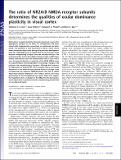| dc.contributor.author | Cho, Kathleen K. | |
| dc.contributor.author | Khibnik, Lena A. | |
| dc.contributor.author | Philpot, Benjamin D. | |
| dc.contributor.author | Bear, Mark | |
| dc.date.accessioned | 2009-12-28T18:46:55Z | |
| dc.date.available | 2009-12-28T18:46:55Z | |
| dc.date.issued | 2009-03 | |
| dc.date.submitted | 2008-08 | |
| dc.identifier.issn | 0027-8424 | |
| dc.identifier.uri | http://hdl.handle.net/1721.1/50258 | |
| dc.description.abstract | Bidirectional synaptic plasticity during development ensures that appropriate synapses in the brain are strengthened and maintained while inappropriate connections are weakened and eliminated. This plasticity is well illustrated in mouse visual cortex, where monocular deprivation during early postnatal development leads to a rapid depression of inputs from the deprived eye and a delayed strengthening of inputs from the non-deprived eye. The mechanisms that control these bidirectional synaptic modifications remain controversial. Here we demonstrate, both in vitro and in vivo, that genetic deletion or reduction of the NR2A NMDA receptor subunit impairs activity-dependent weakening of synapses and enhances the strengthening of synapses. Although brief monocular deprivation in juvenile WT mice normally causes a profound depression of the deprived-eye response without a change in the non-deprived eye response, NR2A-knockout mice fail to exhibit deprivation-induced depression and instead exhibit precocious potentiation of the non-deprived eye inputs. These data support the hypothesis that a reduction in the NR2A/B ratio during monocular deprivation is permissive for the compensatory potentiation of non-deprived inputs. | en |
| dc.description.sponsorship | Whitehall Foundation | en |
| dc.description.sponsorship | National Institutes of Health | en |
| dc.description.sponsorship | Howard Hughes Medical Institute | en |
| dc.language.iso | en_US | |
| dc.publisher | National Academy of Sciences | en |
| dc.relation.isversionof | http://dx.doi.org/10.1073/pnas.0808104106 | en |
| dc.rights | Article is made available in accordance with the publisher's policy and may be subject to US copyright law. Please refer to the publisher's site for terms of use. | en |
| dc.source | PNAS | en |
| dc.title | The ratio of NR2A/B NMDA receptor subunits determines the qualities of ocular dominance plasticity in visual cortex | en |
| dc.type | Article | en |
| dc.identifier.citation | Cho, Kathleen K. A et al. “The ratio of NR2A/B NMDA receptor subunits determines the qualities of ocular dominance plasticity in visual cortex.” Proceedings of the National Academy of Sciences 106.13 (2009): 5377-5382. | en |
| dc.contributor.department | Massachusetts Institute of Technology. Department of Brain and Cognitive Sciences | en_US |
| dc.contributor.department | Picower Institute for Learning and Memory | en_US |
| dc.contributor.approver | Bear, Mark | |
| dc.contributor.mitauthor | Khibnik, Lena A. | |
| dc.contributor.mitauthor | Cho, Kathleen K. | |
| dc.contributor.mitauthor | Bear, Mark | |
| dc.relation.journal | Proceedings of the National Academy of Sciences of the United States of America | en |
| dc.eprint.version | Final published version | en |
| dc.identifier.pmid | 19276107 | |
| dc.type.uri | http://purl.org/eprint/type/JournalArticle | en |
| eprint.status | http://purl.org/eprint/status/PeerReviewed | en |
| eprint.grantNumber | R01 EY018323–01 | en |
| dspace.orderedauthors | Cho, K. K. A.; Khibnik, L.; Philpot, B. D.; Bear, M. F. | en |
| mit.license | PUBLISHER_POLICY | en |
| mit.metadata.status | Complete | |
